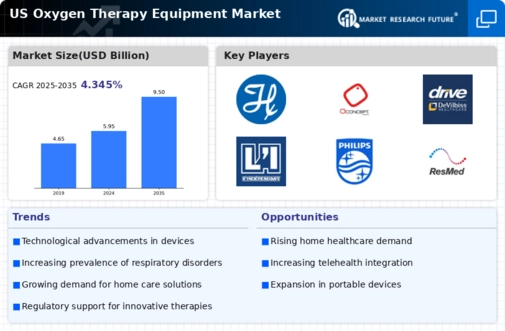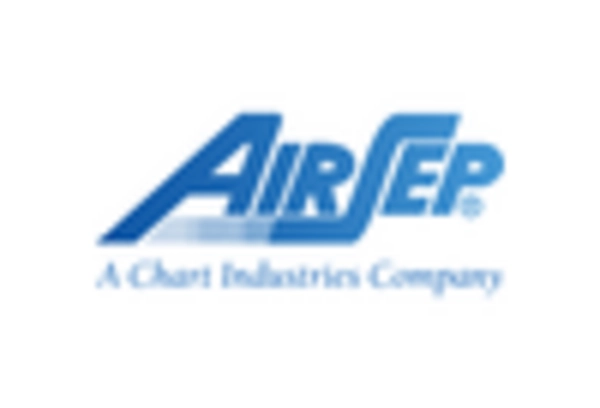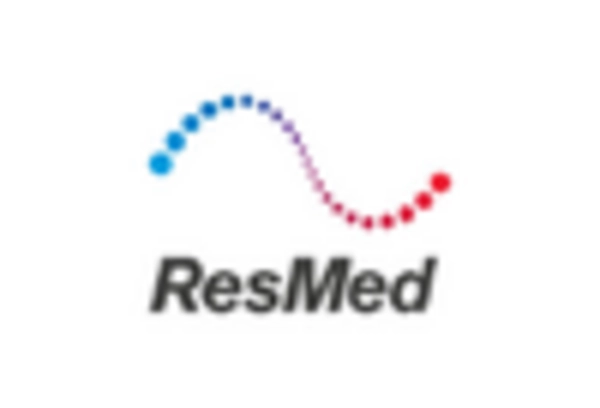Aging Population
The demographic shift towards an aging population in the US significantly impacts the oxygen therapy-equipment market. As individuals age, the likelihood of developing respiratory issues increases, leading to a higher demand for oxygen therapy solutions. The US Census Bureau projects that by 2030, all baby boomers will be over 65 years old, resulting in a substantial rise in the elderly population. This demographic is particularly susceptible to conditions requiring oxygen therapy, such as pneumonia and heart failure. Consequently, healthcare systems are adapting to meet this demand, which is expected to drive the growth of the oxygen therapy-equipment market. The market is likely to see innovations tailored to the needs of older adults, including user-friendly devices and enhanced portability.
Increased Awareness and Education
There is a growing awareness and education regarding respiratory health and the benefits of oxygen therapy in the US. Healthcare providers are increasingly emphasizing the importance of early diagnosis and treatment of respiratory conditions, which is likely to drive demand for oxygen therapy equipment. Public health campaigns and educational initiatives are informing patients about the availability and advantages of oxygen therapy, leading to a more proactive approach to managing respiratory diseases. This heightened awareness is expected to contribute to the growth of the oxygen therapy-equipment market, as more individuals seek out these solutions to improve their health outcomes. The market may also see an increase in demand for home-based oxygen therapy solutions, as patients prefer to manage their conditions in the comfort of their homes.
Supportive Reimbursement Policies
Supportive reimbursement policies in the US are playing a crucial role in the growth of the oxygen therapy-equipment market. Insurance coverage for oxygen therapy has improved, making it more accessible for patients who require these services. Medicare and Medicaid programs provide coverage for medically necessary oxygen therapy, which encourages patients to seek treatment. This financial support is likely to increase the number of individuals utilizing oxygen therapy equipment, thereby expanding the market. Additionally, private insurers are also beginning to recognize the importance of covering these therapies, which may further enhance market growth. As reimbursement policies continue to evolve, the oxygen therapy-equipment market is expected to benefit from increased patient access and affordability.
Technological Innovations in Equipment
Technological innovations in oxygen therapy equipment are transforming the landscape of the oxygen therapy-equipment market. Advances in portable oxygen concentrators, for instance, have made it easier for patients to receive therapy while maintaining an active lifestyle. These devices are becoming more efficient, lightweight, and user-friendly, which is likely to enhance patient compliance and satisfaction. Furthermore, the integration of smart technology into oxygen therapy devices allows for better monitoring and management of therapy, providing healthcare providers with valuable data. As these innovations continue to emerge, the oxygen therapy-equipment market is expected to expand, catering to the evolving needs of patients and healthcare professionals alike. The focus on enhancing user experience and therapeutic effectiveness is likely to drive further investment in research and development.
Rising Prevalence of Respiratory Disorders
The increasing incidence of respiratory disorders in the US is a primary driver for the oxygen therapy-equipment market. Conditions such as chronic obstructive pulmonary disease (COPD) and asthma are becoming more prevalent, affecting millions of individuals. According to the CDC, approximately 16 million Americans are diagnosed with COPD, and this number is expected to rise. As a result, the demand for oxygen therapy equipment is likely to increase, as patients require supplemental oxygen to manage their conditions effectively. This trend indicates a growing market for both portable and stationary oxygen devices, as healthcare providers seek to improve patient outcomes and quality of life. The oxygen therapy-equipment market is thus positioned for growth, driven by the need for effective management of these chronic respiratory diseases.

















Leave a Comment